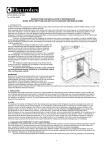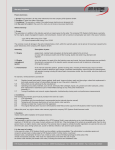Download A school kid runs by. I tell him it`s electric. He says he knows
Transcript
Mahindra Reva e2o : Official Review The Mahindra e2o has been launched in India at a price of between Rs. 5.95 - 6.25 Lakhs (on-road Delhi). What you'll like: • • • • • • Help save the planet. Zero tailpipe emissions and smaller carbon foot-print 'Auto box' & quick start-off are an absolute pleasure in stop & go traffic Tech-dream: GPS, reverse camera, feature laden head-unit, smart phone integration Cute size is a boon when finding parking and maneuvering in the city Interior fit and finish are a leap ahead of the Reva-i & bring it on par with today's hatchbacks ABS body panels are dent resistant and less prone to ugly scratches What you won't: • • • • • • High price outside of Delhi results in negligible overall cost savings Limited battery range makes you think twice about every journey 83km/h top speed & sub-par dynamics make it unsuitable for the highway Only 2 doors; inconvenient as a family car Brakes have an unpredictable and sudden bite to them Lack of power-steering makes parking difficult. Bad news for a city run-about Electric Cars & India A school kid runs by. I tell him it's electric. He says he knows, he saw it on the Discovery Channel. A roadside hero wants to know if it's the 'Pixel'. Two curious bystanders tell me that I must be mistaken about the 7 lakh price-tag. Another says that it's worth the money to go green, especially with the super-low running costs. The businessman drops in a word on the 80% depreciation - really good for companies, he says. The less clued in folk seem excited when they find out it’s a Mahindra! One wanted to know if he could fit a CNG kit on it… The road ahead for electric vehicles in India sure is going to be an interesting one! Does Electric Make Sense? There's a debate about how 'green' fully-electric cars like the Mahindra e2o really are. Sure, they have zero tailpipe emissions, but the electricity is still being produced (creating pollution) elsewhere. This act of taking pollution away from the cities to other locations is called decentralizing pollution. Moral implications aside, it's considered to be a good thing. We'd only be de-centralizing power (not pollution) if hydro, nuclear, solar and wind were the major sources of power, but India still gets around 60% of its electricity from coal, with the next biggest chunk coming from petroleum. Taking a deeper look, 'internal combustion engines' found in conventional cars are extremely wasteful – they run at about 25% efficiency, and less than 20% of the energy makes it to the road. All the other energy gets wasted as heat. Now, car engines have to be designed as portable and light, whereas power stations can be huge and heavy, enabling them to harness energy that otherwise gets wasted. This makes power stations 2-3 times more efficient than car engines. They also have far better means of converting the resultant bi-products into more eco-friendly elements. Keep this in mind when people say that electric vehicles are only moving the pollution problem further away from us. Are electric vehicles the correct way forward for the future? I'm not an expert on the subject, but I think they are definitely a step in the right direction. Perhaps, EVs will find their success working in tandem with other new-age fuel & power source technologies. Price & the Indian Market In other markets, Governments have seen the need to reduce their oil consumption and provide several incentives to EV owners. Some of the biggest advantages of electric cars include the ability to have heavy congestion taxes waived or circumvent traffic by getting access to exclusive 'car-pool lanes'. Unfortunately this doesn’t apply to us. However, I'm sure our Government will add perks for EV buyers once they are under more pressure from the car manufacturer's lobby. Why would such a small car cost so much? Well, my best guess would be a mix of unharnessed economies of scale, expensive imported batteries, heavy taxes and lack of subsidies...all adding up. Delhi offers a 29% subsidy on electric cars. Other states haven't followed suit yet. It's unclear if the Central Government has a subsidy planned, even though talks have been happening for years now. It's hard to do an apples-to-apples comparison between the e2o and any other car in the Indian market. The disparity between electric vehicles and fueled ones becomes apparent once any figures are compared on paper. If we were to compare, would we choose its competitors based on price? Running costs? Alternative fuels? Automatic transmission? Vehicle size? Features? Engine power? To be honest, EVs are still new in India and at this price-point, prospective e2o buyers are those early adopters who have an ideology in their minds that makes them want to purchase an electric-vehicle. All the specs and figures are just supplementary guidelines for comparison. We'll follow a similar approach with the comparo sheet below, choosing a mix of cars that relate to specific facets of the e2o well (but not as a whole). This will help you guys put some things into perspective. As you can see, this isn't a budget car. It's close to premium hatchback territory, especially in the non-subsidy cities. The higher cost is negated to some degree by the extremely low running costs (we'll calculate these later in the review), but it's still not at a point where it makes undeniable financial sense. If you're considering a company purchase, don't forget to work in the advantage of that 80% accelerated depreciation (related post (SCOOP : Detailed Reva NXR pictures. UPDATE: Badged as the "E2O"))! The e2o's lower "T0" variant has the same equipment and features as the top-end "T2" variant we tested, except for the touchscreen audio system and the USB, Aux-in & reverse camera that come connected to it. Also, let me set the comparison benchmark here. I’m treating the car like a full-featured hatchback. It's no longer a quirky little toy like the Reva-i; the e2o is here to play with the big boys. We drove the e2o on the traffic-packed potholed streets of Mumbai. We drove it like it was any other test-drive car. We didn’t baby it at all, and we didn't go easy on it for fear of running out of charge. \\ Interiors At the Front Get seated in the cabin, and you'll immediately realize that the e2o's fit and finish are good. Nothing looks cheap, flimsy or ill-fitted. The materials and colours have been tastefully chosen. Everyone who saw it was very impressed and there's no comparison with its predecessor, the Reva-i. However, we have to compare it to other cars from the same price bracket and so, we'll say it's well on-par with the interior quality of its price-wise competitors. The door hinges are fairly snug, making the light ABS-plastic clad doors feel like they have some serious heft to them, when they are being opened and shut. All rubber beadings (around the doors and rear hatch area) are well fitted and feel like they are of good quality too. Get inside and there's a surprising amount of space in here. The e2o's external dimensions are similar to the Nano. When seated at the front, it comes close to matching the excellently packaged Nano for space as well. It's fairly airy in here, and the tall-boy seating position makes intelligent use of the interiors. The front seats are high-perched (remember, the battery pack is located below them). They have a 'dining chair' like seating position, very similar to the WagonR. This is not cool or sporty, yet it's very comfortable. Legroom and headroom for taller drivers aren't an issue at all. The black wood-finished trim used to highlight parts of the interior is very subtle and tastefully done. The shiny trim looks just like a piano-black finish, unless you look at it more closely. The steering feels chunky and has some contours molded into it. The material textures and cross-stitching are nice too. On the other hand, the stitching at the cutout for the thumb-rests is fairly sharp and pokey. On longer drives, this started to hurt my thumbs. There's no rake or reach adjustment either, so depending on your seating position, the view of the top of the instrument cluster can get blocked out by the top of the steering wheel (as was the case for me). The IRVM too has a similar issue. You can only see about 100 meters back, since it's mounted higher than the top of the rear windshield. The roof cuts off any view beyond that. The blue backlit instrument cluster with white text looks crisp and modern. It's very clearly visible in the day as well. When you press the start/stop button, it requests you to authenticate the key by holding it near the button. This didn't work too well though, with the key only registering about 1 in 3 times for us. It was frustrating! You don't need to authenticate the key to turn on the A/C or other accessories. It's only required to drive the car. Gearshift Interestingly, Mahindra has gone with a conventional looking "Automatic" gearshift. The earlier prototypes had a forward/reverse rotary knob on the dashboard (since in reality, it's just an electrical switch). They have probably done this to keep things familiar, making the e2o look more like a "normal car". Indians are skeptical enough of electric cars as it is, so the closer this looks to what they are comfortable with, the better. On the front of the gearshift is a softtouch button that needs to be pressed in order to shift the lever. Only the shift between "Forward" and "Boost" doesn't require a press of this button. Another interesting marketing move is the fact that they've badged the e2o as an "automatic", when in reality, it's a singlespeed transmission. Window switches are located behind the gearshift. There is no one touch up / down functionality. All the switchgear in the cabin has a solid feel. The indicator stalk has the lanechange functionality where it blinks 3-times on a soft press. Air-Conditioner The air-conditioner is impressive, even on hot Bombay afternoons with no sunfilm on the windows. The blower has 6 selectable speeds, each one being marginally more powerful than the next. I used speeds 1 & 2 which did a satisfactory job, even with the onset of summer. The compressor is an electric unit, and the e2o even has a heater mode for the colder days. The cabin & ambient temperature are shown alternatingly on the instrument display. If you're stuck in awful traffic, running only the A/C for a full hour uses roughly 10% of the e2o's battery charge. Irritatingly, the A/C always starts off as a blower only. You have to turn the temperature knob (manually) each time you want to activate the A/C. Not only does this happen when you first turn on the car, but also if you turn the blower off for just a minute and then restart it. Audio & Entertainment System The e2o has a 6.2" touchscreen audio and entertainment unit. It is a fairly high-resolution resistive screen, quite responsive and loaded with a host of features, and a "carbon fiber" wallpaper too. Inputs include DVD playback, USB (with iPod integration), Bluetooth (phone & audio streaming), 2x Micro-SD slots (Media & GPS data), a 3.5" AUX-in and apparently a composite AUX-in as well. GPS navigation is provided, and the fact that it is integrated with the distance to empty (DTE) count of the e2o is awesome. It can show you charging stations & service centers within your battery range. The reverse camera too shows up on this screen, and the music automatically mutes once you engage reverse gear. I don't think I've seen such a host of features on a head unit in this segment, or even in cars at twice the price! It's worth noting that the lower 'T0' variant doesn't get this head unit and all its ancillaries. The system is advertised as having 4 JBL speakers. The settings menu indicates support for a sub-woofer pre-out too. However, the sound was tinny, and there was absolutely no bass. The mids too were weak. In this condition, I would have given the sound quality a 6/10. DBHPian SS-Traveller did get a chance to try the audio system in another e2o, and he said the sound was surprisingly good, which confirmed my suspicion that there was some sort of speaker connection problem in our test car (the equalizer settings were fine). At the Rear Being a 2-door, you have to flip the front seats forward to access the rear. Pull one of the two available levers, and the whole seat slides ahead in a very smooth manner, almost like its motorized. Squeezing through the gap requires you to hunch over a bit, but once you're seated, it's comfortable and there is sufficient legroom. Thanks to the tall-boy design, leg space is comparable to the smaller hatchbacks. Head room isn't a problem either, even for taller occupants. Each rear passenger gets a small molded armrest on the side panels, which wears a padded and stitched fabric inset like the front doors. Adjustable head-rests and 3point seat belts are part of the package. Two adults can sit back here quite comfortably, but the option for squeezing in a 5th passenger doesn't exist. Safety On the safety front, the e2o does not offer airbags or ABS. It does have 3-crumple zones, and given that it is soon to be sold in Europe, it has been designed with the NCAP crash tests in mind (though the results aren't out yet). Front seatbelts have a pre-tensioner function, and rear passengers get 3-point ALR seatbelts which enable the use of a child seat. It gets central locking, an immobilizer, adjustable head restraints for all 4 passengers and follow-me-home headlamps. Steering is chunky, nicely textured and good to hold. Unfortunately, no steering-mounted audio controls are present: Display is futuristic and functional. SOC is 'State Of Charge'. RPM meter at the top works like a speed indicator as it's a single-speed transmission: The center console clad with a shiny black wood finish trim. 6.2" touch screen is the entertainment hub: Rotary knobs for the A/C are well put together and easy to use: Front seats are perched over the battery pack. The seats look basic, but they are comfortable. e2o themed stitching pattern: The intruding wheel-arch tends to touch your foot when you press the accelerator. Dead pedal is huge: Gearshift follows the familiar auto-tranny design. "B" is for "Boost" mode. Window switches are placed behind the gearshift: There are a few storage cubby holes as part of the center console: Start / stop button is more like an on / off button here, as engine cranking is not part of the routine: Wiper and indicator stalks feel solid and don't have any ugly plastic mold-lines visible: Door pads get a stitched fabric insert, wood finish trim on the armrest, and a chromed door handle & lock: Bottle holder with an elastic string to keep it from rattling. Front speakers are positioned in the foot-well: USB / iPod, Aux-in and a 12v lighter socket are found in the cubby hole ahead of the gear lever: The glovebox is pretty basic. Respectable size for a small car like this. Remote shown as a size reference: Electrically adjustable outside mirrors give you a sufficient view of what's behind: Rearward visibility is limited due to the dropping roof-line and thick C-pillars: Front seats can be slid forward by using either of the 2 levers shown here: The rear seat has the same dual-tone upholstery with a stitched design: Parrys demonstrates the rear headroom. He is 5'7" and there's a good 4-5" of space above him: This is the legroom behind a 5'8" driver: Luggage space is limited to 3 backpacks or 2 small strolleys: Halogen projectors do an excellent job, with a uniform spread of light: Battery Range, Charging & Ownership Costs Range Per Charge How far will the e2o go on one charge? That seems to be the biggest mystery with the vehicle. Mahindra has said "100 kms under test conditions", but people want to know the realworld range. We had the car with us for a few days, so we decided to put it to the test in typical Mumbai conditions. Day 1: Single driver zipping around. 1 person in the car for 80% of the time, 2 people for the balance 20% Air-conditioning was NOT used 50% of the driving was done at night with the headlights on Entertainment screen was on for 30% of the time Boost mode used for 25% of the driving A lot of flyovers and mild climbs encountered RANGE: 87 kms (not including 'revive') Day 2: Extremely rigorous family use. 3 people in the car for 30% of the time, 2 people for 30% and 1 for 40% Air-conditioner ON for 100% of the time 20 minutes of the A/C running when parked Boost mode used for 25% of the driving Entertainment screen on & music playing for 100% of the time Headlights on for 30% of the time 20% of the journey was spent going up and down steep hills You can think of this range test as an extremely heavy-use scenario RANGE: 60 kms (not including 'revive') Given the above numbers, I think it should be possible to get close to the advertised 100 km per charge if you drive conservatively. It's also reassuring that the car is always telling you what your expected range is, so you can alter your driving style if required. Believe me, a range of 87 kms doesn't sound like a lot when compared to internal-combustion vehicles, but I realized just how long 87 kms within the city is. How long would the battery last if it was running just the air conditioner? From some rough calculations, you should be able to get 7-10 hours of cooling, which is plenty. Think of it this way : running just the AC for an hour uses roughly 10% of the battery. You could run the AC in a parked e2o for an hour and only lose ~8 kms of range. As the Battery Runs Out It's important to note that the e2o's performance is virtually the same if it's at 100% charge or 25% charge. Just like your smartphone doesn't perform differently at various charge levels. Below 20% however, the car goes into "Power Saving Mode". Boost mode is disabled and the gear indicator only shows "E" (instead of "F"orward or "B"oost). The e2o can still touch high speeds and climb slopes. It is only the rate of acceleration that is limited in this mode, in order to save battery charge. Below 10%, the gear indicator displays "L" and the display continues to flash "Power Save Mode". The AC compressor also restricts its operation and won't cool as well. The car can still climb steep inclines, but will do so at a slower rate (about 20-25 km/h on steep slopes). At 1% SOC, the display flashes "Stopping" and the e2o beeps softly. Despite this message, the car will continue to move for a while more. For the techies, the e2o's average discharge rate seems to be in the range of 90-140 wh/km. The Tesla S in comparison can pull between 180-380 wh/km. REVive The e2o touts a feature they call "REVive". It's been marketed to sound amazing, like the car can be recharged via airwaves. But in reality, all you are doing is unlocking a hidden reserve charge from the battery. I think it's smart, because of two reasons: 1) Psychological: people feel safer knowing that there is a guaranteed fallback option if they run out of charge. 2) Lithium batteries last longer and stay healthier if they aren't discharged completely (called deep-cycling). Revive can be activated only after the battery level goes below 10% It can be activated in 3 ways. Via the entertainment screen, mobile app or by a phonecall to Mahindra's 1-800 number. When activated, it gives you an additional 7% of battery charge, equating to 5-7 km more range. I don't think there is a limit to how many times you can run a REVive, but it's probably better for your car if you don't make it a habit. Charging the e2o Both e2o variants come with a 48-volt Lithium-Ion battery pack with a 10 kwh capacity. A full charge reportedly takes 5 hours to complete. A 1-hour charge will give you 20% charge (12-20 kms of real world range) Mahindra Reva will help you set up a weather-sealed outdoor charge port at your residence or office, free of cost. It will be connected to your electric meter, which is almost always located on the ground floor. This makes integrating the e2o to your household a lot easier. Mahindra has already set up over 250 charging stations in various cities. Bangalore has the majority of them, with a 100+, and Delhi comes in at a close second with 95. There will be more added soon. It's not a complicated task as it's just a regular plug-point after all! If you're on the road and looking for a charging station, the GPS on the entertainment display can point you to the closest one. Here's a state-wise list of charging stations. A majority of the charging stations are housed within Mahindra & Mahindra dealerships. Additional Charging Information As a safety precaution, the e2o will not move if the charging plug is connected. Trip meter A gets reset every time the charging plug is inserted. Unlike the old Reva-i, these batteries are maintenance free. No need to add distilled water or perform any maintenance yourself. The charging efficiency of the e2o is roughly 90%. This means that 10% of the electricity used gets wasted as heat. Vacation charging mode can be set via your car's personal webpage or the smart phone app. It enables you to set a period for which the battery will be charged at the ideal pace for storage (once in three days). Moderator Moralfibre mentions: There is some "Environment friendly" scheme launched by the government wherein having a battery charging station for electric vehicles gives builders some tax benefit. ( See page 29). The e2o is designed to operate at an ambient temperature of between 10 - 55 degrees centigrade, with no change in power or range. The 5 hour charging time is applicable only if the ambient temperature is within 10 - 45 degrees centigrade. Make sure your wall-socket is properly earthed, else a red light on the e2o plug-head lights up and the car won't charge. The good thing is that you can take only the charging cable along to test a plug-point (no need to move the car). A green light comes on if it's all good. Tip: Ensure that your entire household wiring uses an Earth Leakage Circuit Breaker (ELCB). It can protect your entire house from electrical fires. Alternative Charging Technologies Mahindra also offers a "Sun2car" solar charging station. The panels cover an area of 9 square-meters. However, at the current price of Rs. 1 - 1.6 Lakhs, it seems to be more of a topic of conversation than a feasible option for personal use. "Quick2Car" are the high-speed public charging stations that might be available soon. They claim 25 kms of charge in 15 minutes, or 60-70 minutes for afull charge! A lot of people asked what sense the e2o makes in a country with such irregular power and constant load-shedding. Well, here's a googly from Mahindra Reva: "Car2Home" is something they might introduce in the future that lets you power your home using the car's batteries. From my rough calculations, you could run 5 x 60w light bulbs for 40+ hours with an e2o battery. Ownership & Service Costs The paradox of electric cars is that they have unbeatably low running costs per km, but they also have severely limited km range per day. Catch 22! Proper quick-charging infrastructure should alleviate the problem in the near future. Mechanically, the e2o is a lot simpler than every other fossil-fuel powered car out there. There's no shiftable transmission. No alternator. No water pump. No fuel pump. No fuel filter. No belts to snap or replace. The general rule of thumb is that less complexity = less points of failure & less maintenance required. The standard warranty on the e2o (excluding battery) is 3 years / 36000 kms. The batteries come with a warranty of 3 years / 60,000 kms. The battery packs have fairly advanced monitoring for voltage and temperature. As a result, range and performance shouldn't see a decrease as the battery ages. Mahindra claims the battery will last for 5-7 years if taken care of well, and they say they have tested the battery for more than 120,000 kms with no drop in performance. A replacement battery costs Rs. 1.5 - 2.5 lakh (though it might have gone down by the time you have to replace it 3-5 years from now). Hope for the future of EVs? In the USA, it's actually required by law to warranty the battery pack for a full 8 years (10 years in California). 3 free services are included with the e2o (1 per year). Service technicians will visit your home for the service! Mahindra says estimated service costs are Rs. 1,500 - 2,000 + taxes per service. It's a lot cheaper since there is no oil change required. Team-BHP ownership reports of the Reva-i said that the Reva sales staff and after-sales support were well-informed, eager and provided an excellent experience. Ownership Calculation : Delhi This includes the vehicle, fuel & electricity at Delhi prices. Top variants chosen. We used a fairly conservative 1200 km per month of running. Battery cost has been assumed to be 2L (4 years from now). We've heard figures ranging from 1.5 - 2.5L and Mahindra says its difficult to predict the price. Ownership Calculation : Bangalore The same calculation as above, but with the vehicle, fuel & electricity at Bangalore prices. Ownership Calculator : Other Cities / Different Running You can download the XLS file (e2o Running Cost Calculator.xls) and input your own figures too. Note that the more kms you run per month, the more things go in favour of the e2o, due to its extremely low cost per km. Light near the charging port is very useful (most people will be coming home and plugging in at night): Supplied charging cable is 15-feet 6-inches long: You'll never have to visit this place again! Just kidding. You still have to go to the pump to set your tyre pressure right: Here's where the current 90+ charging stations in Bangalore are located: Other Points Other Points: • The previous Reva was known as the “G-Wiz” in London, where it was relatively popular because it was exempt of London's steep congestion charge. • Pre-e2o, the company had sold 4,500 Revas in 24 countries. • The e2o is currently available in Delhi, Bangalore, Mumbai, Pune, Ahmedabad, Hyderabad, Chandigarh, and Kochi. A European launch is on the cards for later in 2013. • As a safety measure, the e2o wants you to shift to Neutral after it is switched on. • You can shift between "F"orward and "B"oost without pressing the button on the gear lever. However, every other shift requires that button to be pressed. • If you press the gear lever button, you can even switch from forward gear into reverse while the car is moving! This happens even at speeds of 15 km/h. I don't know if any other kind of protection has been built in, but I didn't risk trying to find out. • You don't need to press the brake when shifting gears or starting the car. It would have been a better practice if they required that. • When you park on a hill, you're relying ONLY on your hand brake. Unlike conventional cars, the transmission provides no resistance here. This lack of a double braking mechanism can be scary for people like me, whose permanent parking spot is on an incline. • The car is extremely quiet when in motion, so people do not hear you coming. Keep this in mind and use the horn liberally to warn unsuspecting pedestrians. Thankfully, the horn is loud. • The electric motor is sealed, and so is the battery compartment (except for the raised airinlet for cooling). Minor flooding and water wading shouldn't be an issue. There are videos online of the e2o being driven through 8" deep water for testing. • The indicator stalk got stuck in the downward position on day 2 of our drive. It had to be forced back up and wouldn't function smoothly after that. Ironic that it happened soon after we made a comment on the solid feel that the indicators had. • Parrys says: small size, cool-factor and city-friendly nature make it an ideal car for selfdrive rental companies (eg. Zoomcar). He adds, if you charge your cell phone in the e2o, you'll be able to make more calls but drive less far. • Mahindra should have really pushed for a high subsidy in Karnataka. Multiple reasons; their factory is based there (more incentive for the government to help) and Bangalore had the highest number of Reva-i owners. Delhi NCR (where the subsidy is currently offered) typically has extremely long commuting distances compared to other cities in India. • Came across a few bugs with the AC controls and instrument display. Eg. The trip-meter mode button has a delay before it activates. The AC blower suddenly went to top-speed, even though it was at the slowest setting. • Back around 2012, along with the NXR (now rebadged as the e2o), Reva had also announced the possibility of the "NXG" - an electric sports coupe. I wonder if we'll ever get to see that on the streets. • Last year, Mahindra had stated that they would lease battery packs to e2o owners to help reduce initial costs & take the fear of the significant battery replacement cost away. I thought this was a brilliant idea, but unfortunately it hasn't been implemented. • Mahindra has just confirmed that an all-electric Verito will be launched within a year. They are already being used on some of Mahindra's campuses. • Hybrid vehicles sound like a more natural first step towards getting Indians to adopt EV technology. However, hybrids are typically a lot more expensive than pure EVs, and this would be a big deterrent in our price sensitive market. • I really liked Mahindra's pre-launch campaign. The "Ask Movement" : The Smaller Yet Significant Things Mobile Application Available on iOS, Android and BlackBerry. We tested the Android version. The app has a very polished look. It's not one of those cheap apps that exist just for the sake of having an app. Once activated, it takes about 8 seconds to establish a connection; this delay prevents it from being a replacement for the key-fob when it comes to unlocking & locking the doors. I wish it was faster. The most useful feature is seeing the current state of charge and range, or how much your vehicle has charged when it's plugged in. Ability to remotely turn on the AC is 'cool', especially since you also see the interior temperature of your vehicle. There was a scheduling option for turning on the AC, but the functionality seemed incomplete. The app can show you where the charge points are located, and your range overlaid on a Google map (as the bird flies). The green circle is the area in which you can complete a round-trip, while the red circle is the one-way range. For more specific trip info, you can use the "Plan your trip" option which uses Google's routing to determine the actual distance of the planned trip. If you leave the Android app and come back to it later, there is a time-stamp showing how old that information is; there is no way to "refresh" and see the updated info (eg. Charge level). This means that on Android, you have to kill the app every time you want to use it again. Mahindra offers a "Personal webpage for your car" which would probably be the same information presented online - for those who don't have supported smartphones. The entertainment screen can show the car's vitals, GPS, Reverse camera and a graph of your driving efficiency: Choice of inputs, the audio playback screen and advanced audio settings: Rear speakers are mounted on the fixed tail-gate. Notice the tiny tweeter's position too (near the seat belt): 13" alloys have painted spokes with a machine-polished face: A few additional fuses and a communications port under the rear seat: Center mounted prop-up for the plastic hood. LED light is a thoughtful addition, especially if you have a puncture at night: This is the electric air-con compressor. Its got rubber mountings to reduce vibrations: Spare tyre is secured in place behind the A/C condensor fan. Tip : ensure the concave side of the wheel faces the fan to allow maximum airflow: Thick insulation in the boot damps out some of the noise from the electric motor: The feature-rich head unit even comes with its own remote: Despite the rear seats folding forward to create more luggage space, the sign advises against placing anything heavy on them: Rear seats flipped down give it a respectable amount of luggage space. There is no 60:40 seat split: Remote buttons require a hard press. Boot open button is useful (for plugging in the charging cable). Not a very high quality remote: Heat sink on the underside of what might be the motor and battery control unit: I found a plug-point near my parking spot! Turns out, the earthing wire wasn't connected, causing the red light to come on: Investing in an extension cable might be a good plan for a rainy day! The e2o uses the larger 15-Amp plug that most fridges and air-conditioners use. The more commonly found 5-Amp plug is shown on the right: Manufactured in a space-age looking factory. They’ve kept the manufacturing process extremely eco-friendly too. Read-more: Impatient? When plugged in, the "TTC" (Time To Charge) figure is displayed at the bottom right of the display: User manual is an audio-visual presentation with a voice-over that plays on the speakers. The screen displays useful graphics and hints at the location of features within the menu:















































